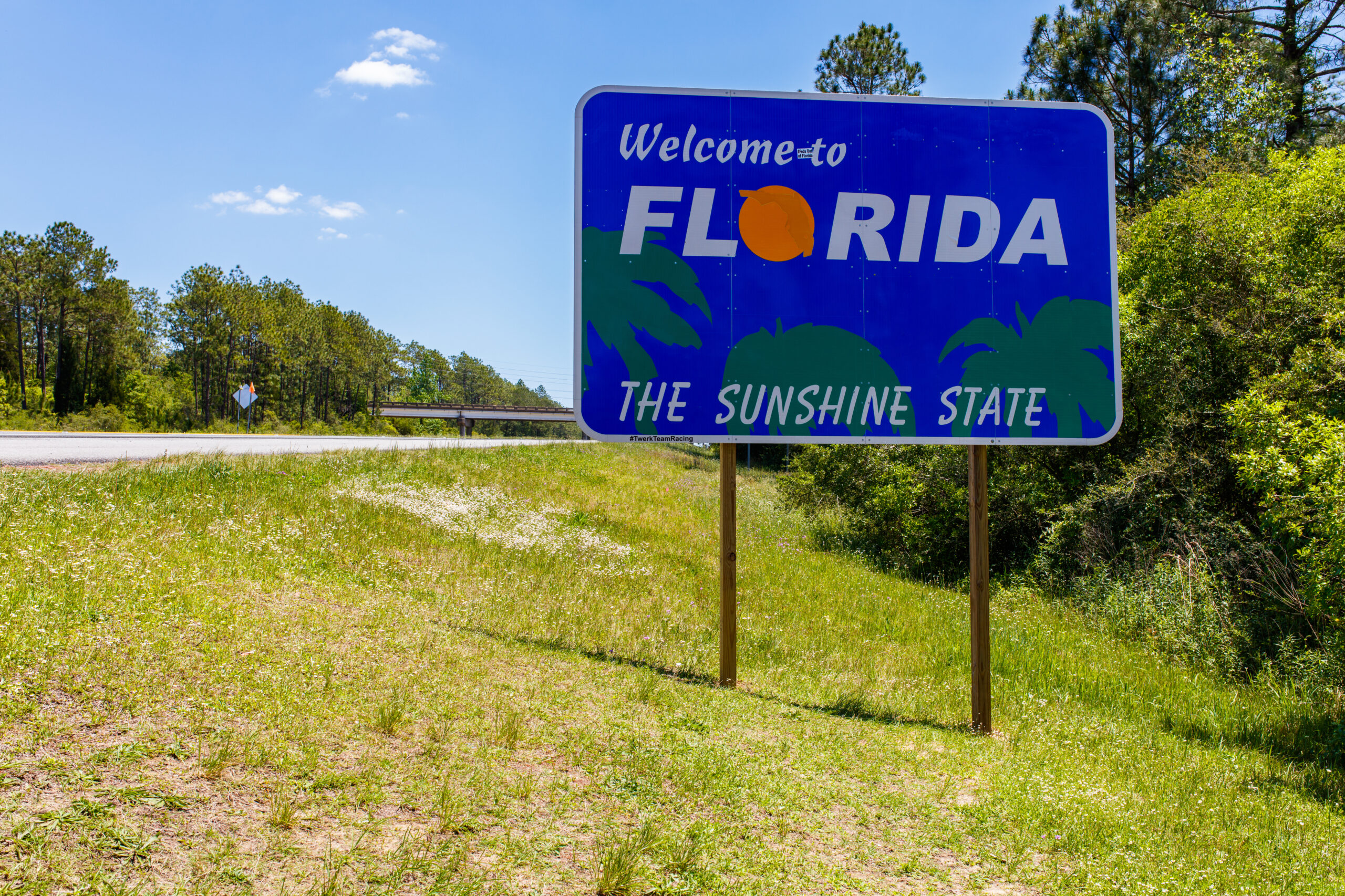Florida is a state of endless reinvention — a peninsula suspended between ocean and sky, between myth and memory. It is the Sunshine State, but its light has many shades: golden over the Gulf, silver along the Atlantic, and amber in the still waters of the Everglades.
To travel through Florida is to move through a series of changing worlds. The sleek skyline of Miami rises from a foundation of Caribbean rhythm and Latin color; in the Keys, coral islands stretch like stepping stones into the sea. The center of the state hums with imagination — from Orlando’s theme parks to orange groves glowing under the winter sun. Along the Gulf Coast, sugar-white beaches melt into gentle tides, while to the north, moss-draped oaks whisper the stories of the old South.
Florida is both wild and cultivated, glittering and raw. Its landscapes are shaped by paradox — mangroves and malls, gators and golf courses, ancient swamps and neon skylines. Yet beneath it all, there’s a pulse of vitality that is purely Floridian: a belief in renewal, in the promise that the next sunrise will bring something bright and new.
Artists, wanderers, and dreamers have always been drawn here. They come for warmth and escape, but stay for the sense that this land — shifting, fluid, unpredictable — mirrors something in themselves.
In the end, Florida is more than a place. It is a mood, a mirage, a state of becoming. It is America’s final frontier of light and water, where the continent dissolves into the sea and the horizon feels infinite.
Miami – The City of Light and Pulse
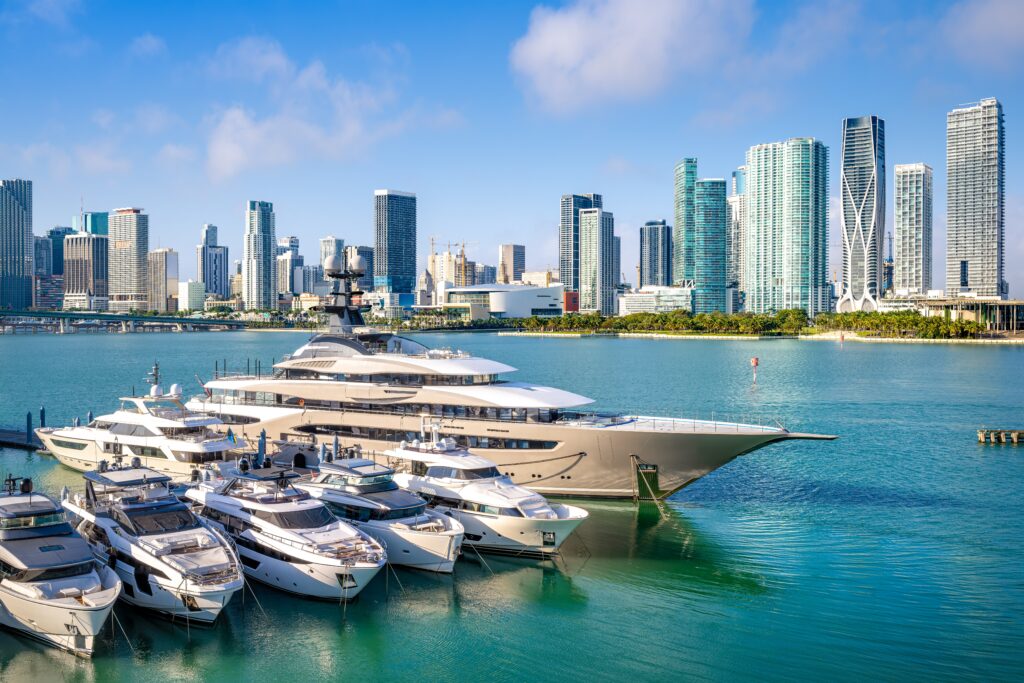
Miami is not merely a city; it’s a living rhythm. Rising from the edge of Biscayne Bay, it glows with tropical energy — a mosaic of cultures, languages, and styles that seem to shimmer in perpetual motion.
Little Havana breathes the scent of roasted coffee and cigar smoke; Wynwood bursts with color and street art; downtown towers reflect both ambition and heat. Yet Miami’s soul lies in its contradictions — its glamour and grit, its speed and sensuality.
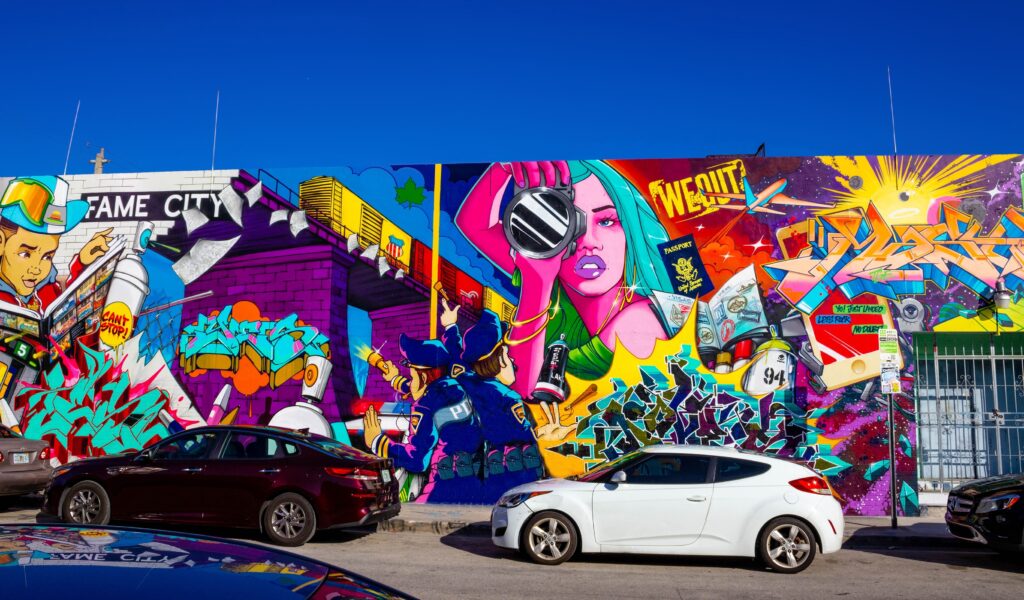
By day, sunlight floods the pastel skyline; by night, neon reflections ripple across the water. This is a place that reinvents itself daily — where Cuban beats meet modern art, and ocean breezes carry whispers of every language on earth.
Miami doesn’t sleep; it thrums. It’s the heartbeat of modern Florida — vibrant, cosmopolitan, and alive with the promise of possibility.
Miami Beach – Art Deco Dreams and Ocean Air
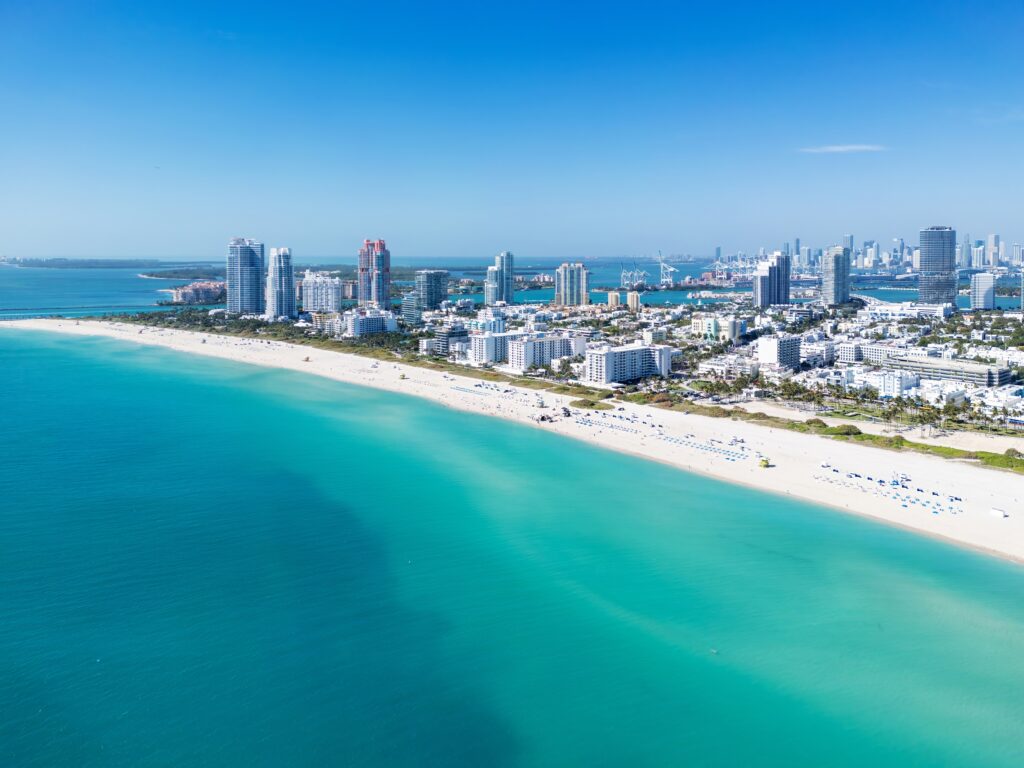
Across the causeway from Miami lies Miami Beach — an island city that feels like both a film set and a fantasy. Ocean Drive curves along the Atlantic, lined with pastel Art Deco hotels that glow like seashells under pink light.
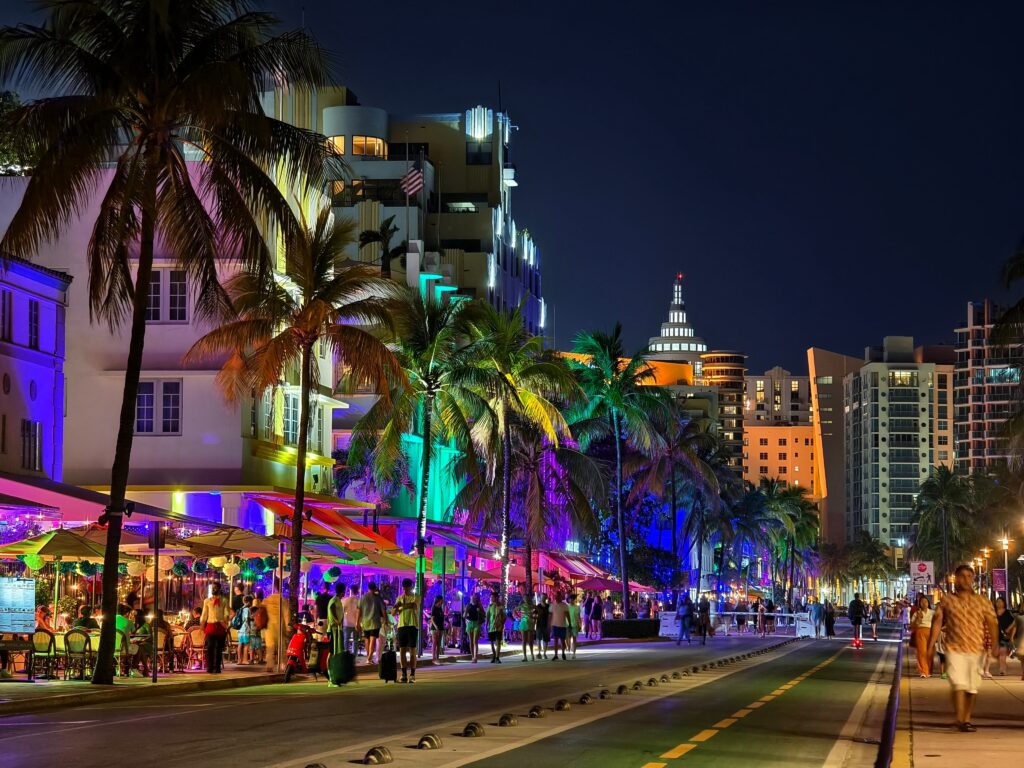
In the morning, joggers and sun-seekers share the sands; by afternoon, the cafés and rooftop terraces hum with life. South Beach embodies the glamour that made Florida famous — fashion, music, and the endless shimmer of sea and sun.
But beneath its glitter, Miami Beach holds a quiet artistry. Its architecture, preserved with loving care, is a living museum of the 1930s. Its sea breeze carries the echoes of Sinatra, the rhythm of salsa, and the sigh of waves.
Miami Beach is where Florida learns to dance — endlessly, joyfully, against the tide.
The Florida Keys – Highway to the Horizon
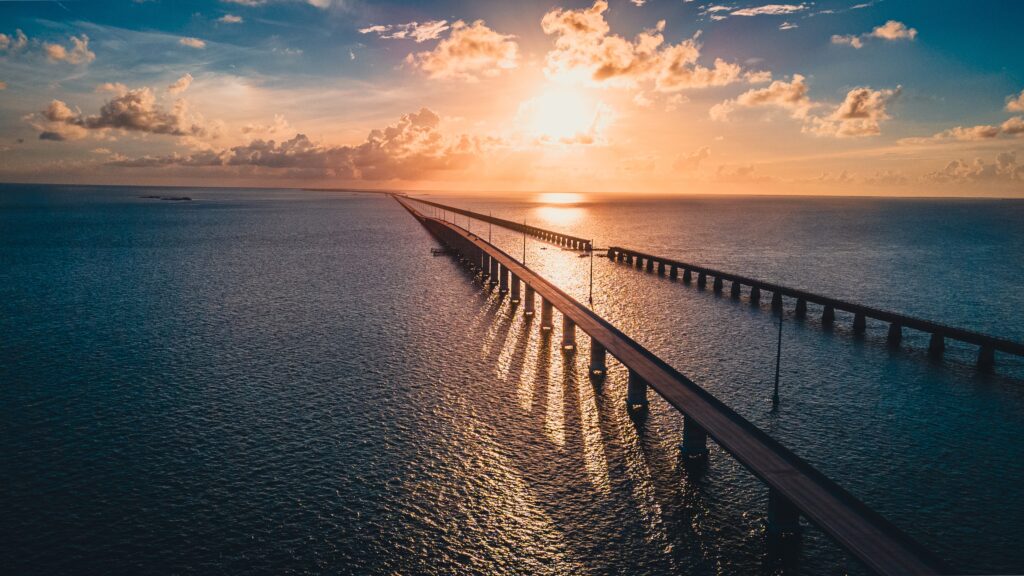
The Keys are a string of coral islands stretching 120 miles into the Gulf — a bridge between the mainland and the Caribbean, between the ordinary and the eternal.
The Overseas Highway winds above turquoise shallows and mangrove flats, each island offering its own pace: Key Largo’s diving reefs, Islamorada’s sportfishing coves, Marathon’s sunsets, Big Pine’s quiet solitude.
The further south you go, the more time seems to dissolve. Here, the ocean and the sky merge into one vast horizon, and every evening the world pauses to watch the sun melt into the sea.

The Keys are Florida at its most elemental — salt, light, and freedom. They are less a destination than a state of mind, where life is measured not in hours but in tides.
Key West – The Southernmost Soul
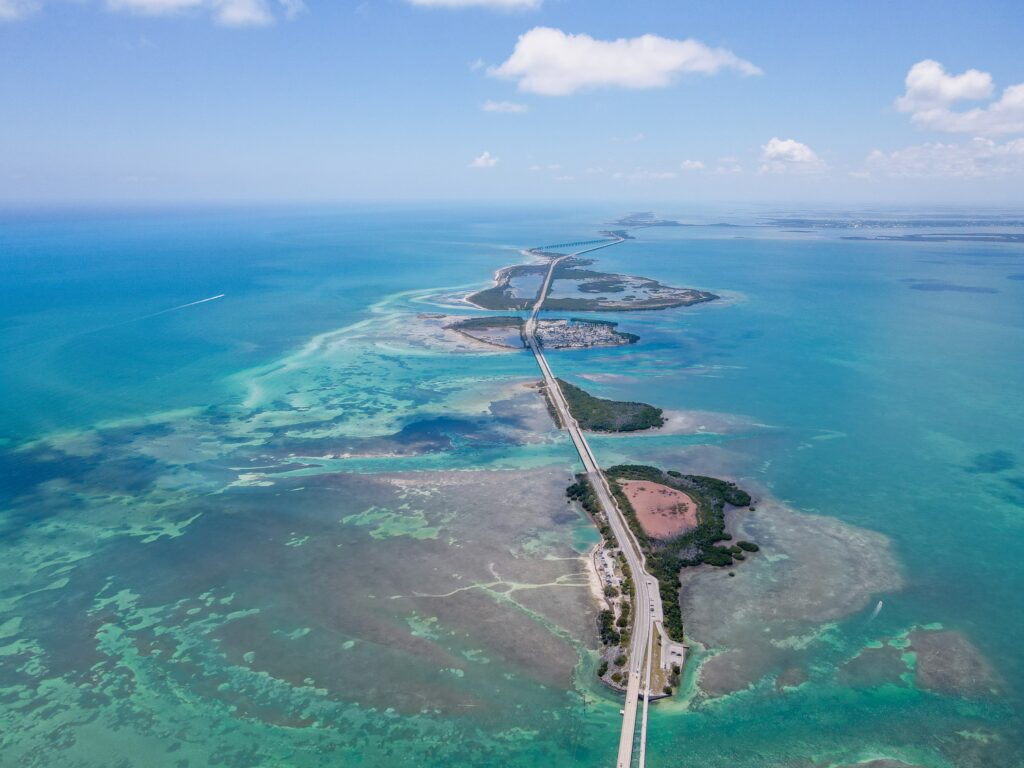
At the end of the highway, where land dissolves into sea, lies Key West — a place that feels half dream, half memory. The island hums with color and contradiction: pastel houses framed by palms, chickens strutting across cobblestones, and the sound of laughter rising from open verandas.

Once a haunt of pirates and poets, Key West still wears its eccentricity proudly. Hemingway’s shadow lingers in his old house on Whitehead Street, its garden alive with six-toed cats. At Mallory Square, crowds gather each evening to salute the sunset — an act of worship as old as the sea itself.
Yet beyond the revelry, Key West has quiet depths. It’s a refuge for wanderers and romantics, a place where no one asks who you were before you arrived. Here, the air tastes of salt and rum, and the horizon feels like freedom.

At the edge of the continent, Key West reminds you that endings can be beginnings — and that paradise is as much a state of mind as a place on the map.
The Everglades – The River of Grass

The Everglades are not a swamp but a slow-moving miracle — a vast, shallow river flowing from Lake Okeechobee to Florida Bay. It is one of the last true wildernesses in America: a cathedral of sawgrass, cypress, and sky.
Here, silence is alive. Alligators drift like shadows; herons stand motionless in the shallows; the wind whispers through endless reeds. The Everglades hold a rhythm older than cities — patient, untamed, and eternal.
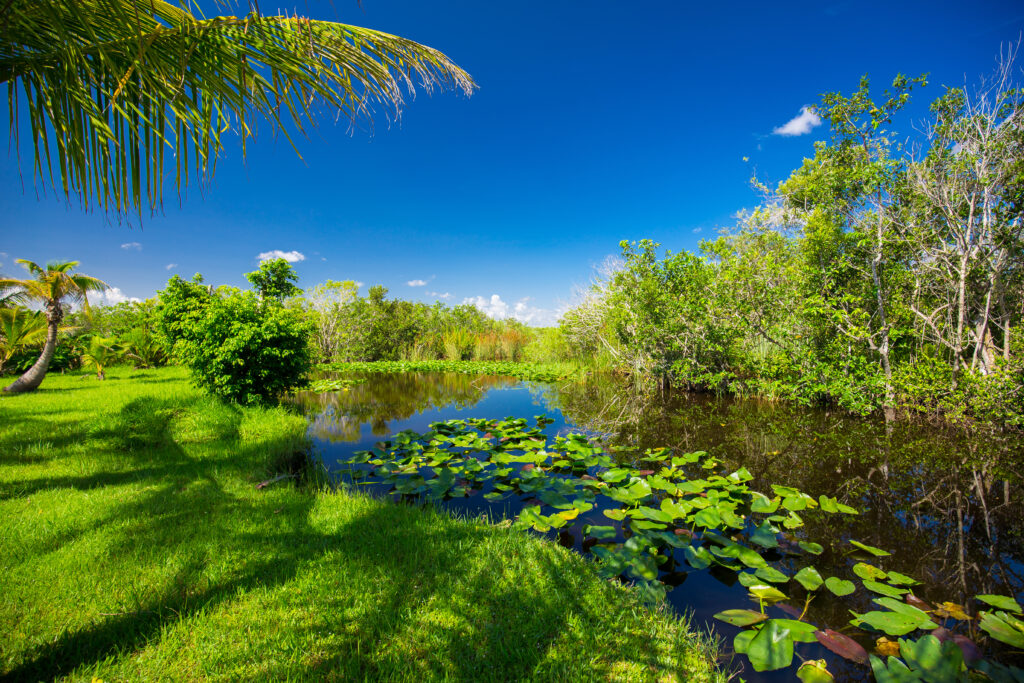
Early morning light turns the water to gold, and by dusk, the horizon glows pink against silhouettes of wading birds. It’s a fragile ecosystem, constantly threatened, yet endlessly resilient.
To walk its boardwalks or glide through its waters is to glimpse the original Florida — wild, mysterious, and deeply alive. The Everglades are not simply a landscape; they are the soul of the state, breathing quietly beneath its modern world.
Naples & Marco Island – The Gulf’s Golden Calm
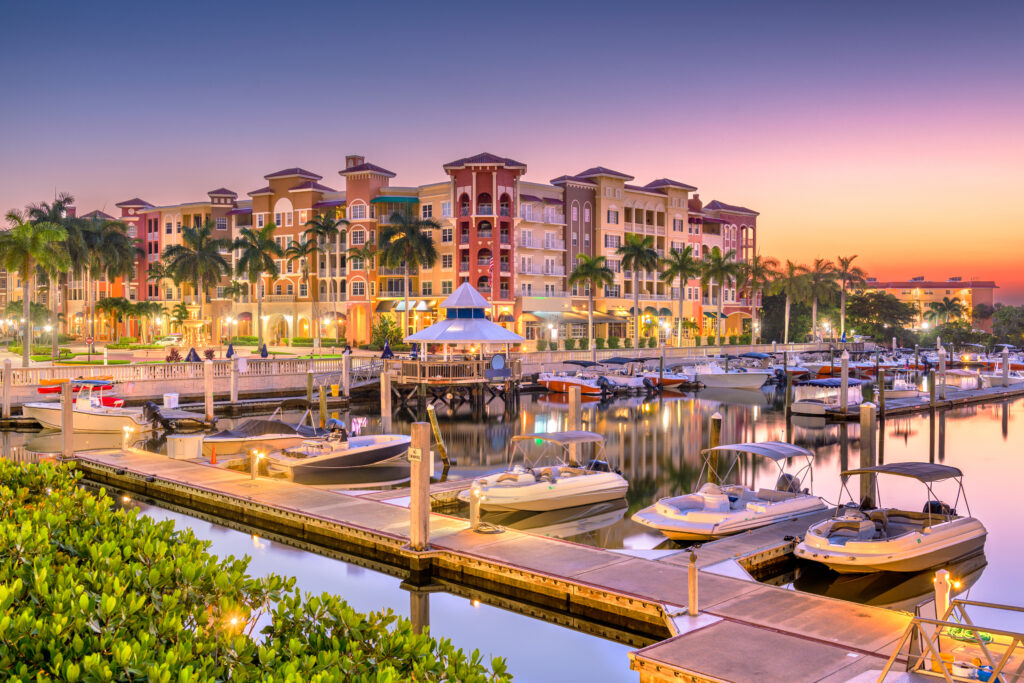
On Florida’s southwestern coast, Naples and Marco Island offer a softer kind of beauty — where refinement meets nature in golden harmony.
Naples, with its graceful avenues and flowering bougainvillea, feels like a Mediterranean dream translated into Gulf sunlight. Art galleries, gardens, and white-sand beaches form its calm rhythm, each sunset painting the horizon in watercolor hues.
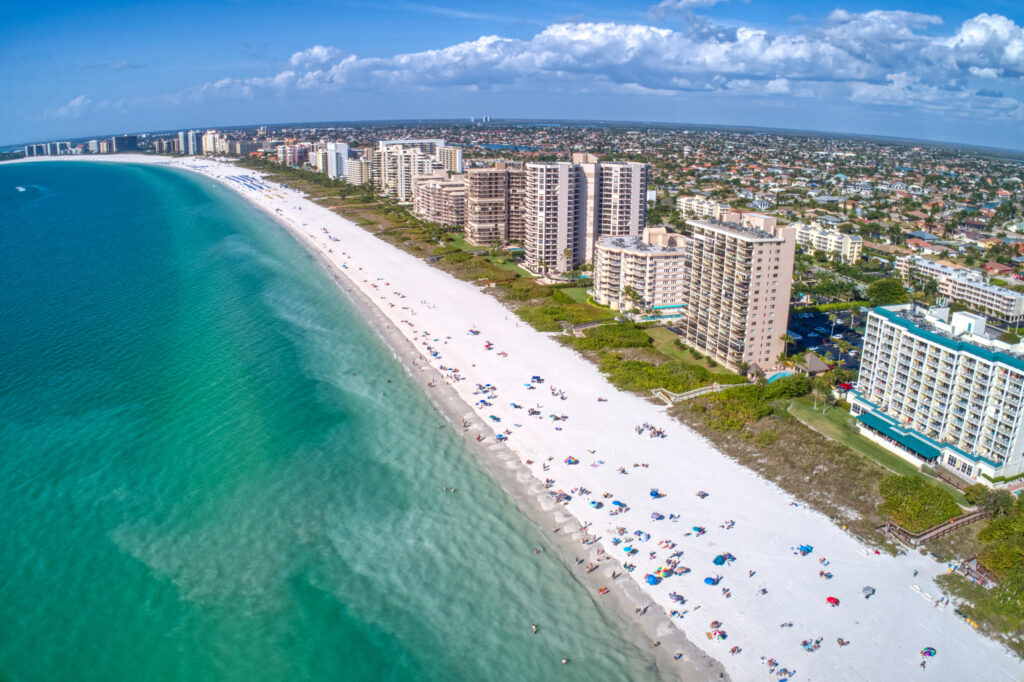
Just to the south, Marco Island is more intimate — a place of shells, sailboats, and slow tides. Dolphins arc through its bays; egrets trace perfect lines over the mangroves.
Here, the luxury is not opulent but quiet — found in the hush of morning surf, the scent of salt air, the feeling that the day belongs only to you. Naples and Marco remind visitors that Florida’s greatest wealth is not gold or glamour, but light, peace, and the soft conversation between land and sea.
Sanibel & Captiva Islands – Shells, Sunlight, and Stillness
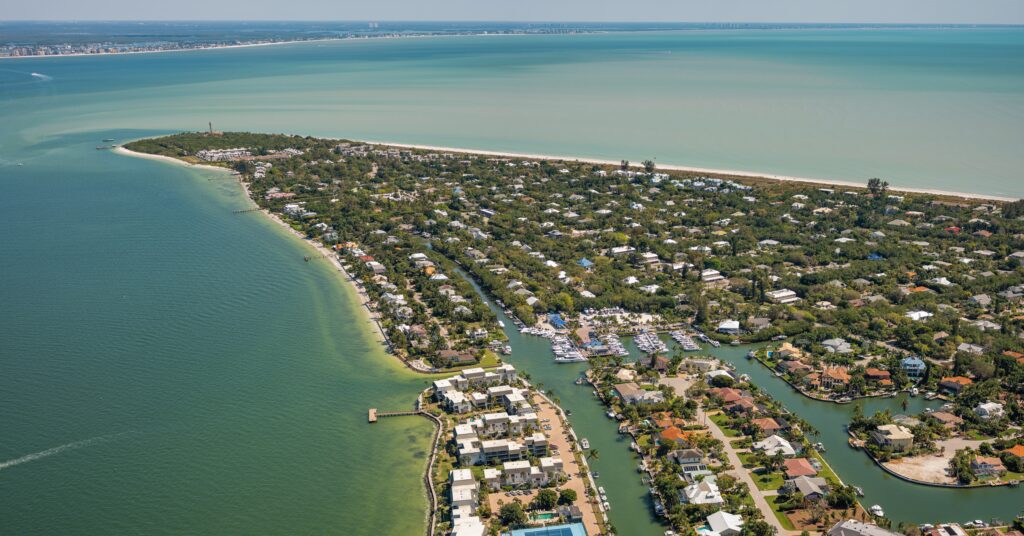
Off the coast of Fort Myers, the twin islands of Sanibel and Captiva seem to float between dream and daylight. Time slows here — not from laziness, but from the island’s gentle insistence that there is nowhere better to be than this exact moment.
Sanibel is world-famous for its seashells — hundreds of species carried ashore by the Gulf’s unique currents. Every morning, visitors bend in the “Sanibel stoop,” collecting pink conchs and delicate coquinas like treasures from a living museum. The J.N. “Ding” Darling National Wildlife Refuge adds another layer of wonder, its mangroves home to roseate spoonbills, manatees, and quiet reflection.
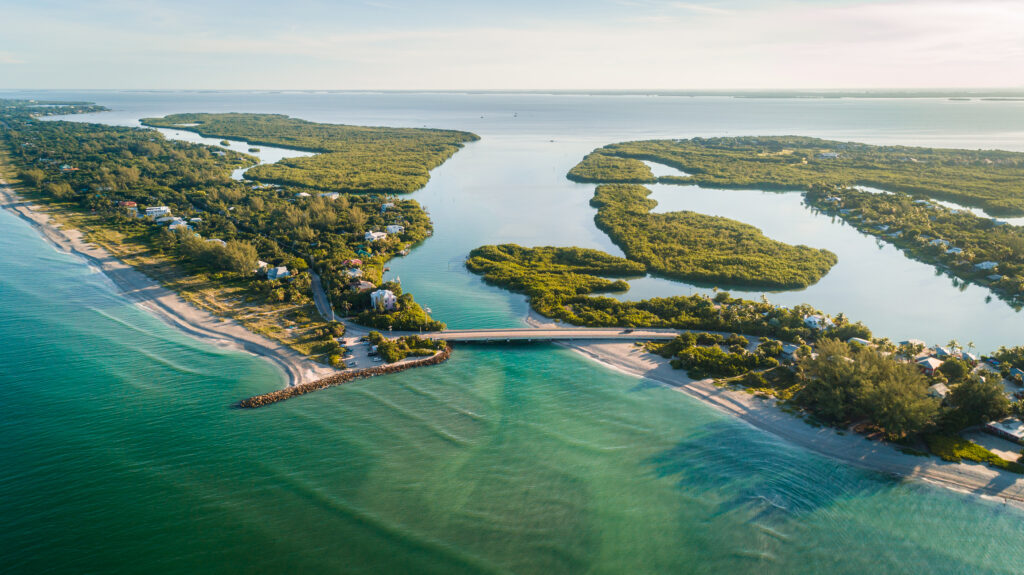
Captiva, Sanibel’s slender sister to the north, feels even more secluded — narrow lanes shaded by palms, cottages kissed by salt breeze, sunsets that set the world ablaze. Life here is measured not by hours, but by tides.
Sanibel and Captiva are not places you visit; they are places that visit you — gently, persistently, until you carry their stillness home.
Tampa – Where History Meets the Horizon
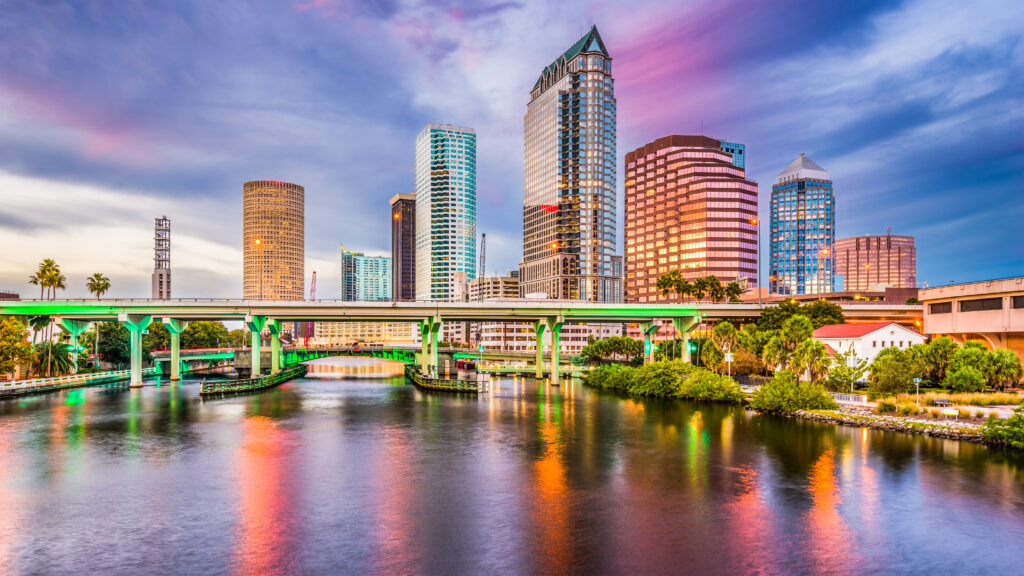
Tampa is a city that holds both memory and motion — a place where cigar smoke from Ybor City’s brick streets mingles with the salt wind from the bay. It is Florida’s great crossroad of cultures: Latin, Cuban, Italian, African, and Southern — a blend that has shaped its rhythm for more than a century.
The historic district of Ybor City still hums with its old-world energy. Iron balconies, colorful murals, and the scent of fresh espresso recall the city’s golden age of cigars and revolution. Downtown, modern glass towers rise beside the restored warehouses of the Tampa Riverwalk, where people stroll beneath palms as pelicans skim the water.
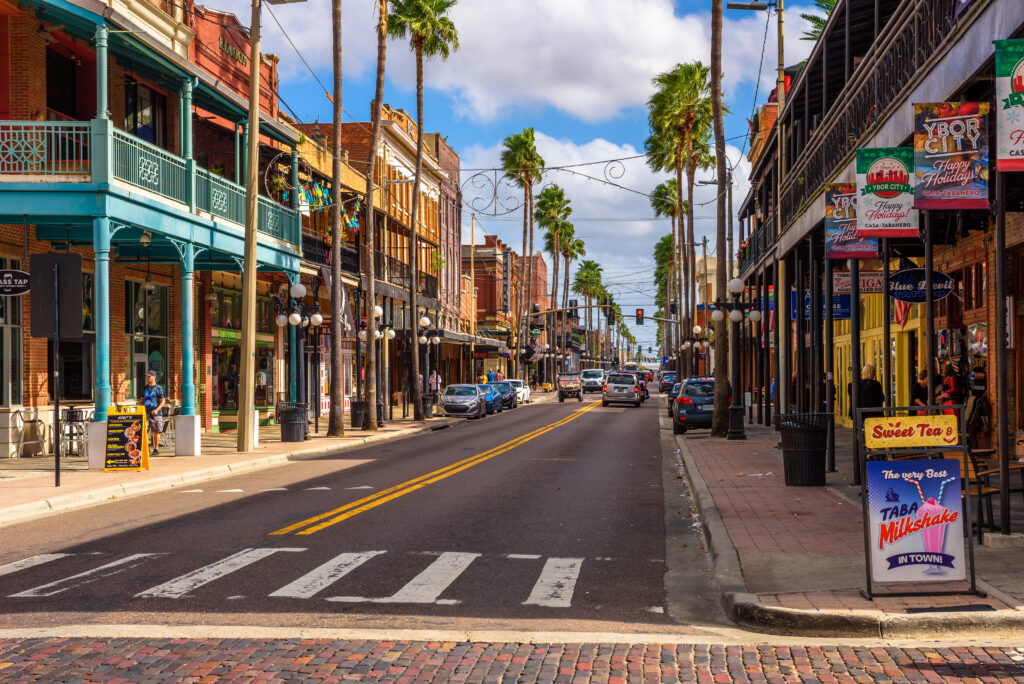
Tampa is also a gateway — to the beaches of Clearwater, to Busch Gardens’ wild rides, to the cultural pulse of the Gulf. Yet it remains grounded in its roots: warm, resilient, and quietly proud.
In Tampa, the past and future coexist — one hand rolling cigars, the other reaching for the skyline.
St. Petersburg – The City of Light and Art
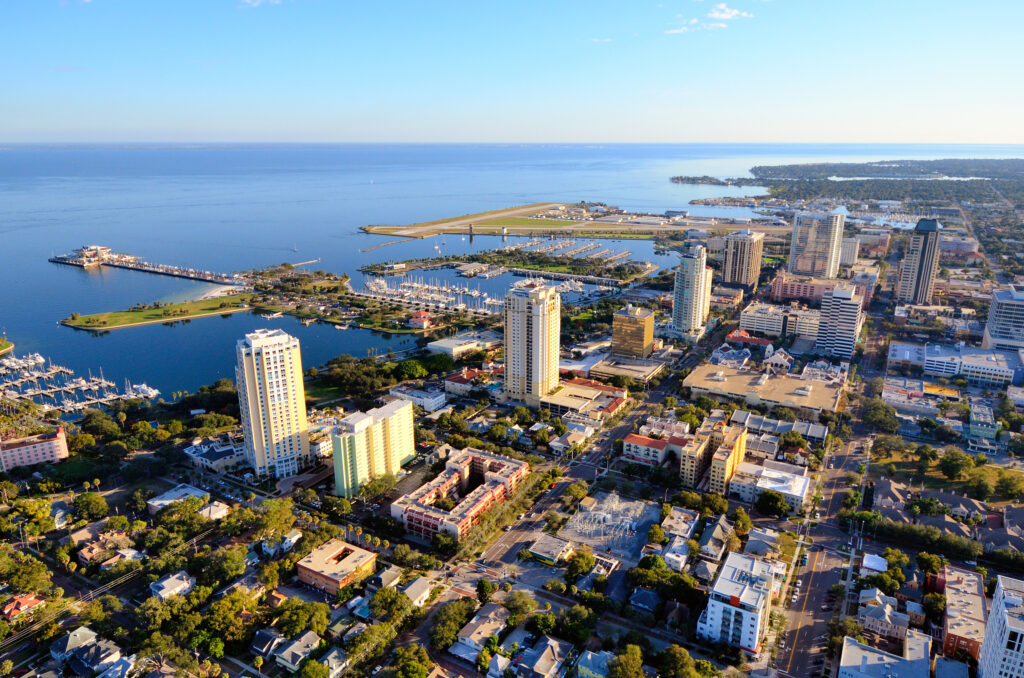
Across the bay, St. Petersburg glows like a watercolor — a city of sunlight, art, and open sea. Known simply as “St. Pete,” it’s where the creative heart of Florida beats loudest.
Once a sleepy retirement haven, the city has reinvented itself as a cultural haven. The Dalí Museum anchors its artistic soul, its surreal architecture mirrored in the surrounding waters. Nearby, galleries, murals, and studios transform downtown into a living canvas — bright, bold, and full of joy.
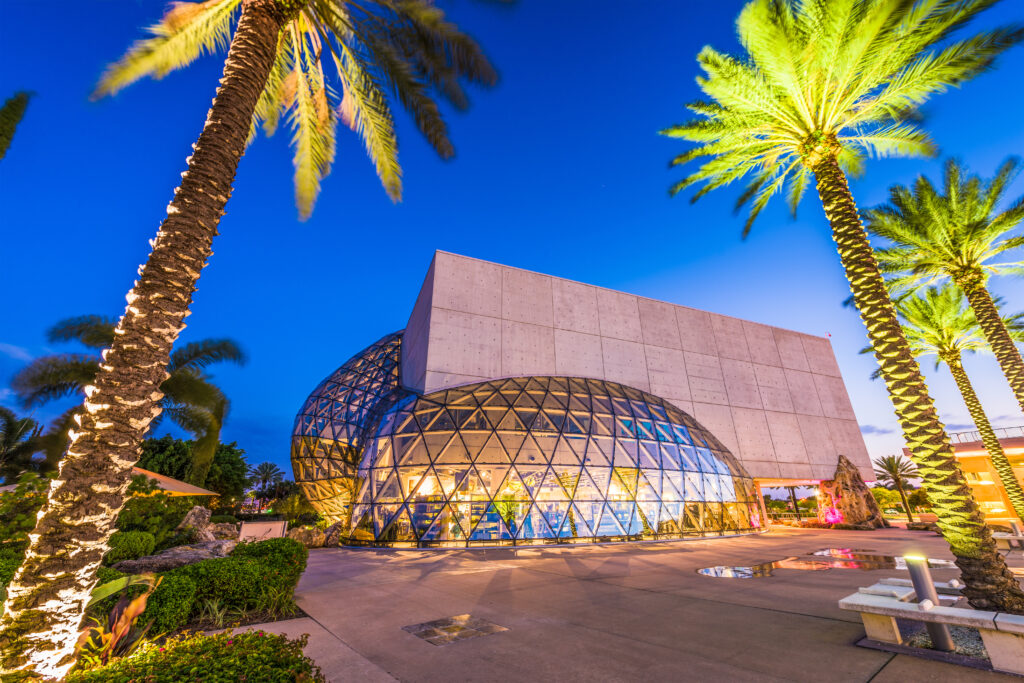
But St. Pete’s magic also lies in its beaches. St. Pete Beach and Pass-a-Grille stretch for miles, their sands so white they seem to hum in the sunlight. Sunset here is not a time of day — it’s a daily celebration. Locals gather, musicians play, and the horizon catches fire.
In St. Petersburg, creativity feels as natural as the tide — flowing, colorful, unstoppable.
Clearwater – The Gulf’s Shimmering Heart

Few beaches in America shimmer like Clearwater Beach, where sugar-white sands meet water so translucent it seems lit from within. This small city on the Gulf of Mexico perfectly captures Florida’s easy rhythm — warm, friendly, endlessly radiant.
By day, Clearwater hums with gentle life: children building castles in the sand, dolphins leaping beside sightseeing boats, the scent of salt and sunscreen carried on the breeze. The Pier 60 Sunset Celebration transforms every evening into a carnival of color and sound — street performers, artisans, and golden light spilling across the horizon.
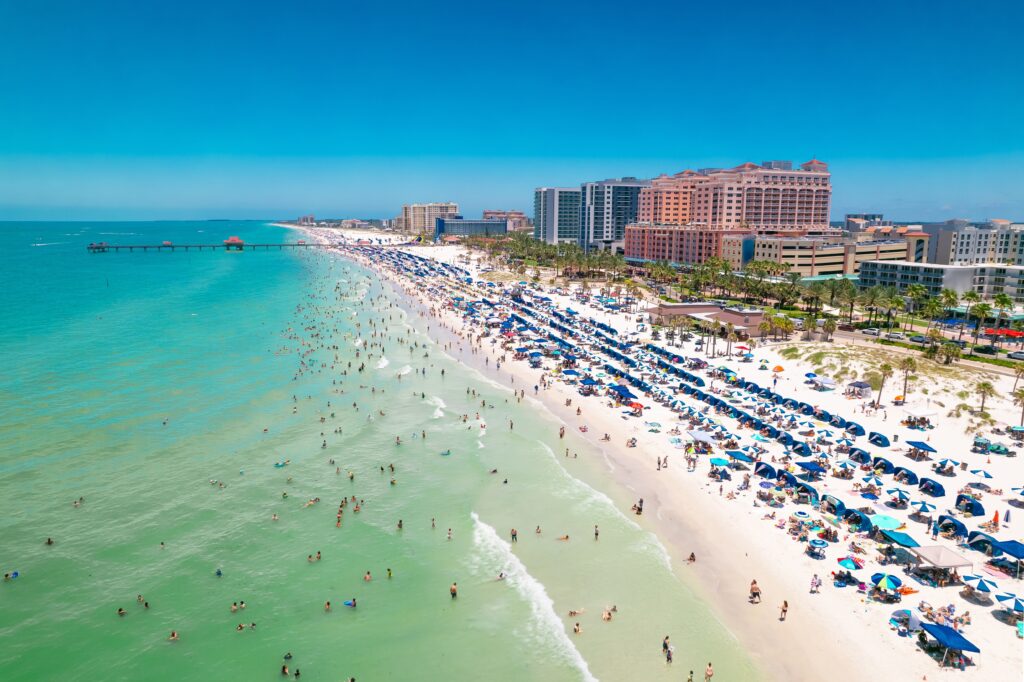
Yet beyond the beach lies another Clearwater: the historic Downtown Cleveland Street District, where small galleries, music venues, and local cafés foster a growing creative energy. The nearby Clearwater Marine Aquarium, home to rescued dolphins and sea turtles, gives this city its beating heart of compassion and care.
Clearwater isn’t only a place to sunbathe; it’s a place to unwind the mind. Its beauty lingers not because it dazzles, but because it heals.
Sarasota – The Art of Coastal Living

If Clearwater is pure sunlight, Sarasota is sunlight refined — cultured, graceful, and quietly sophisticated. Once the winter home of the Ringling Brothers Circus, the city grew around an artistic legacy that still defines it today.

The John and Mable Ringling Museum of Art, a pink Venetian palace filled with Old Masters and lush gardens, feels worlds away from the Florida of palm trees and beach umbrellas. Yet just minutes away, Lido Key and Siesta Key offer some of the softest sands in the world — quartz so pure it stays cool even under the noon sun.

Sarasota has mastered the art of balance. It’s cosmopolitan yet relaxed, elegant yet accessible. Opera, ballet, and theatre thrive alongside farmer’s markets and waterfront cafés. Even its architecture — from mid-century modern homes to bayfront mansions — reflects a community that values design as much as leisure.
Here, beauty is a way of life, and culture breathes with the sea breeze.
Fort Myers – The Gateway to the Islands

Fort Myers is a place of sunlight and story — a coastal city where palm-lined boulevards whisper of old Florida and discovery feels eternal. Once a modest outpost along the Caloosahatchee River, it blossomed into a winter retreat for inventors and dreamers alike.
The Edison and Ford Winter Estates, beautifully preserved with their tropical gardens and workshops, embody that spirit of curiosity. Here, Thomas Edison and Henry Ford spent long seasons experimenting, creating, and escaping northern winters. The banyan tree they planted still spreads across acres — a living metaphor for how deeply roots can take hold in this fertile corner of Florida.

Downtown Fort Myers, revitalized with murals, cafés, and waterfront walkways, hums with gentle energy. Yet beyond the city, bridges stretch toward the barrier islands of Sanibel and Captiva, linking modern bustle with island serenity.
Fort Myers remains a threshold — between invention and rest, river and sea, past and present — and few gateways feel so welcoming.
Orlando – The City of Endless Discovery
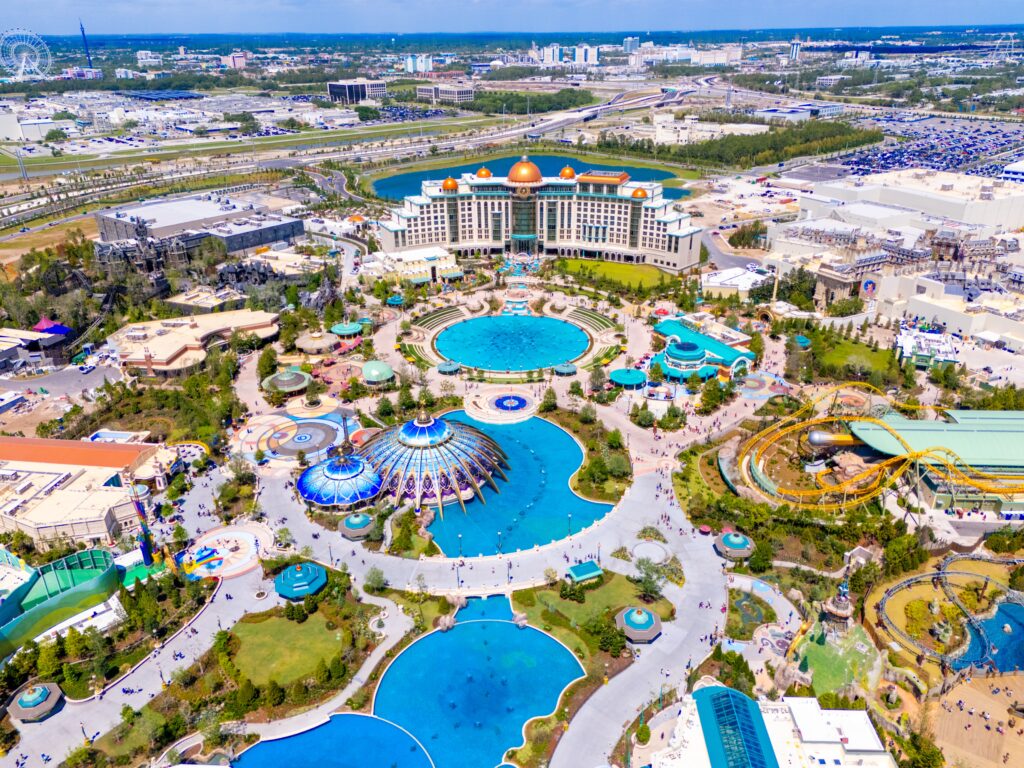
To many, Orlando means theme parks and thrill rides — a place of imagination built on sunshine and spectacle. Yet beneath the glitter of roller coasters lies a city with depth, warmth, and a growing creative pulse.

Downtown Orlando surprises visitors with its tree-shaded streets, elegant Lake Eola Park, and skyline reflected in calm waters. The district’s galleries, craft breweries, and the Dr. Phillips Center for the Performing Arts reveal a community that thrives beyond its famous attractions.
Still, magic is never far away. The nearby theme parks have transformed Orlando into a global crossroads of joy — where families from every corner of the world gather to believe in wonder again. But step beyond the parks, and you’ll find a living, breathing Florida city: one that balances dreams with daily life, commerce with creativity, and sunshine with soul.
Orlando’s greatest trick may not be illusion at all, but transformation — turning every visitor, no matter how old, into a believer once more.
Walt Disney World & Lake Buena Vista – The Kingdom of Imagination
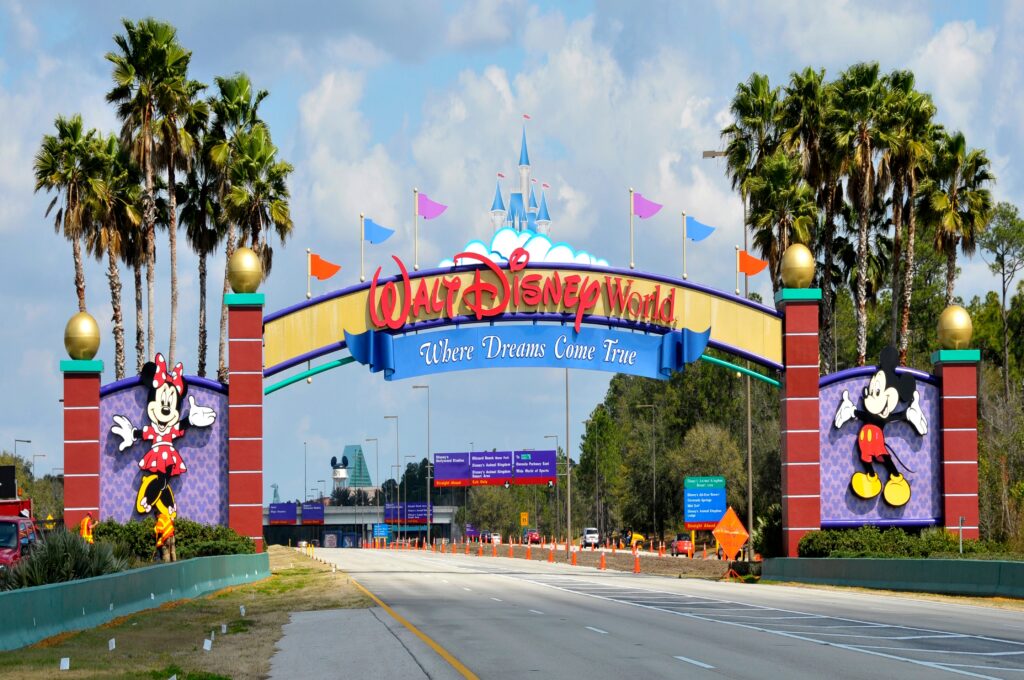
Few places on earth have altered the landscape of fantasy like Walt Disney World. Spread across 25,000 acres near Lake Buena Vista, this vast resort is not merely a theme park — it’s a world unto itself, a modern mythology in motion.
Here, fairy tales rise from Florida swampland: Cinderella’s Castle gleams under fireworks, Epcot’s silver sphere reflects dreams of tomorrow, and animals roam through the immersive savannahs of Disney’s Animal Kingdom. Yet beyond the rides and parades lies something deeper — a testament to human imagination.
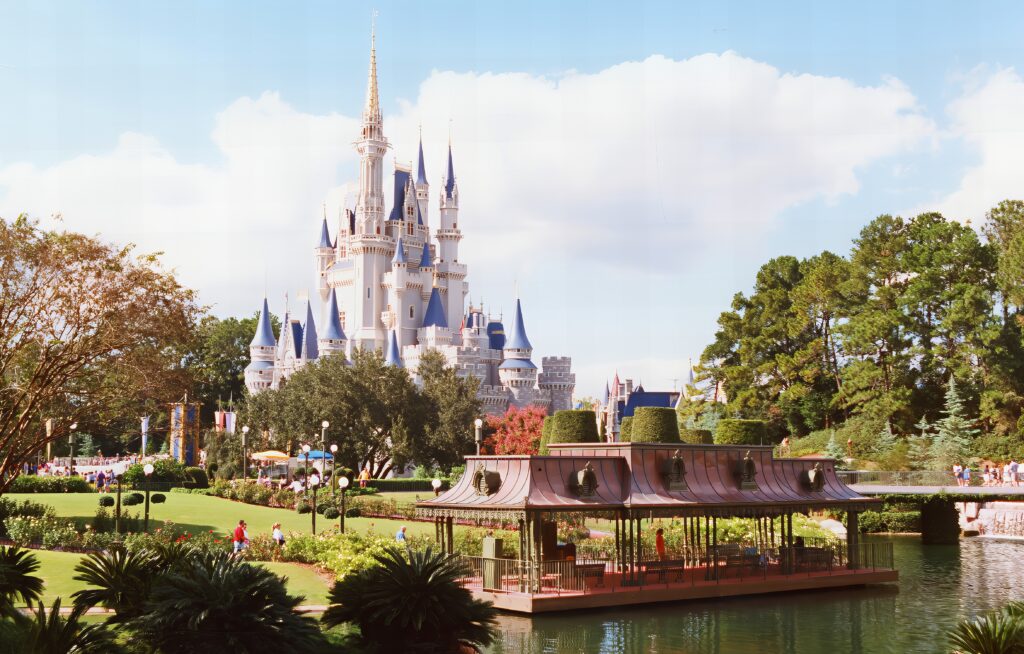
Every detail, from the scent of Main Street popcorn to the precision of nighttime spectacles, reveals Walt Disney’s belief in optimism as an art form. Visitors come seeking escape, but they leave with something subtler — a renewed sense of possibility.
At its best, Disney World is not a fantasy at all, but a reflection of what the human spirit can create when it refuses to stop dreaming.
St. Augustine – America’s Ancient Soul

Founded in 1565, St. Augustine is the oldest continuously inhabited European-established settlement in the United States — a city where cobblestones whisper centuries of stories.
Spanish forts, colonial balconies, and coquina walls transport visitors to another era. The Castillo de San Marcos, a 17th-century fortress overlooking the bay, still stands unyielding against the Atlantic winds. Nearby, St. George Street bustles with life: hidden courtyards, old taverns, and the gentle chime of church bells echoing across terracotta roofs.

But St. Augustine is not a relic; it is a living city of artists, writers, and wanderers drawn to its timeless allure. The air smells faintly of salt and jasmine, and at night, the flicker of lanterns seems to awaken the ghosts of conquistadors and dreamers alike.
St. Augustine is less a destination than a feeling — that rare sensation of standing in the present while touching the past.
Jacksonville – The Bold City by the River
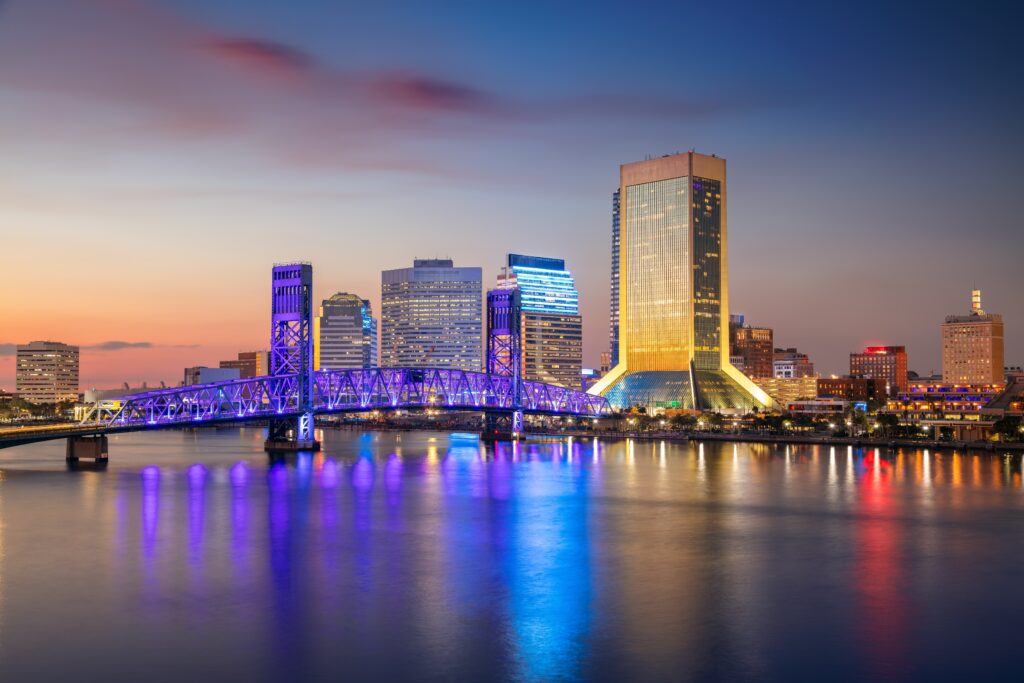
Jacksonville is Florida’s quiet giant — a city of broad horizons, hidden charm, and fierce pride. Set along the St. Johns River, it blends the easy grace of the South with the restless energy of a metropolis on the rise.
Downtown, murals and music spill from every corner; the Riverside and San Marco districts showcase century-old homes, leafy streets, and an ever-growing culinary scene. The river, slow and shimmering, threads it all together — linking the city’s heart to the sea.
A short drive away lies the Jacksonville Beaches, where surfers carve through Atlantic waves and locals gather for open-air concerts at sunset.
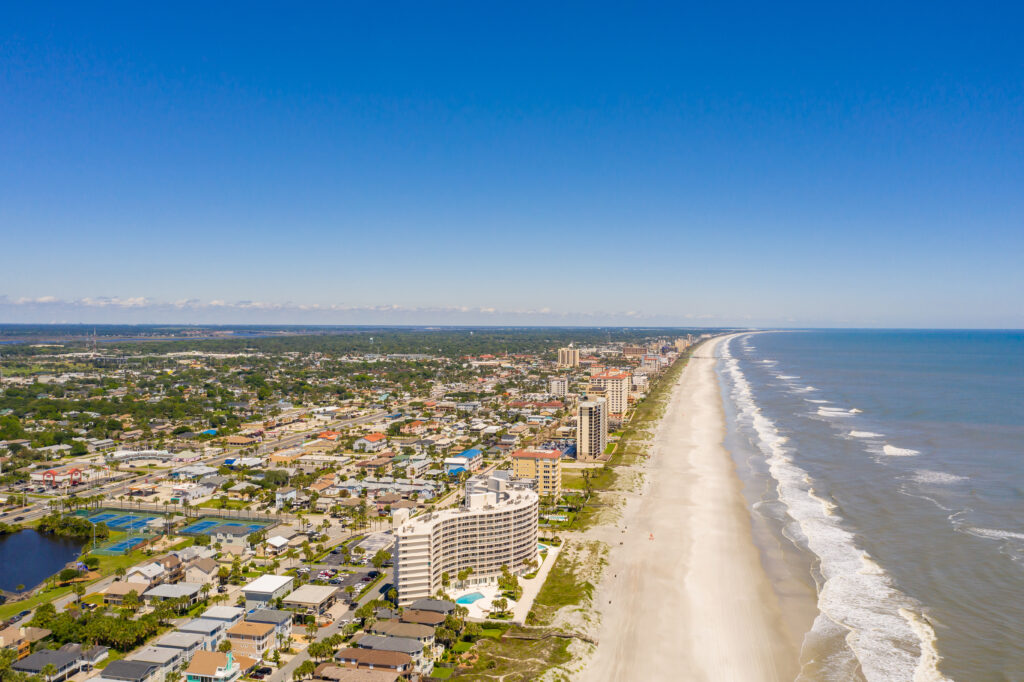
Jacksonville’s beauty is not showy; it’s steady and sincere. It’s a city for those who prefer discovery to display, where culture and coastline, business and soul, coexist in perfect, sunlit rhythm.
The Space Coast – Cape Canaveral & Cocoa Beach

If Florida ever had a frontier of the stars, it would be here — the Space Coast, where rockets rise like modern cathedrals of fire against the Atlantic sky.
At Cape Canaveral and the Kennedy Space Center, history and ambition intertwine. Here, the roar of Saturn V engines once shook the world, launching humanity beyond Earth. Visitors can stand beneath the enormous rockets of the Apollo era, walk through the control rooms of legend, and even watch new missions ignite the heavens.

Just a few miles south, Cocoa Beach offers a softer side to this cosmic energy. Once home to astronauts and surfers alike, its golden sands and retro motels hum with 1960s nostalgia. The iconic Cocoa Beach Pier still stretches proudly into the sea — a place where science and saltwater dreams coexist.
The Space Coast remains one of Florida’s most inspiring landscapes: not for what it is, but for what it dares to imagine.
Daytona Beach – Speed, Sun, and Spirit
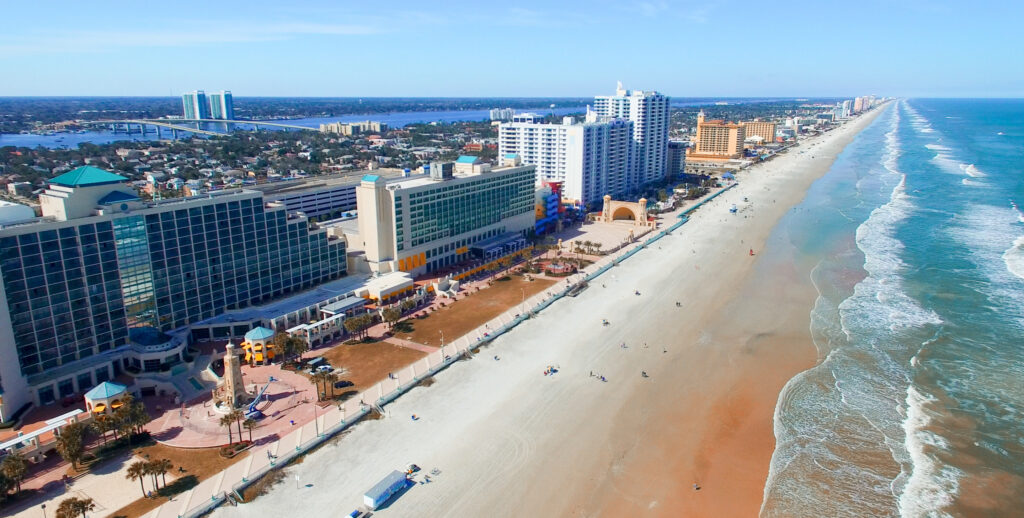
Few places capture the raw pulse of motion like Daytona Beach. For more than a century, its hard-packed sands have been a racetrack, a gathering place, and a stage for celebration.

Before there was NASCAR, there were men and machines chasing the horizon here — engines roaring beside the waves. That heritage still lives on in the Daytona International Speedway, where the famous Daytona 500 attracts fans from across the globe.
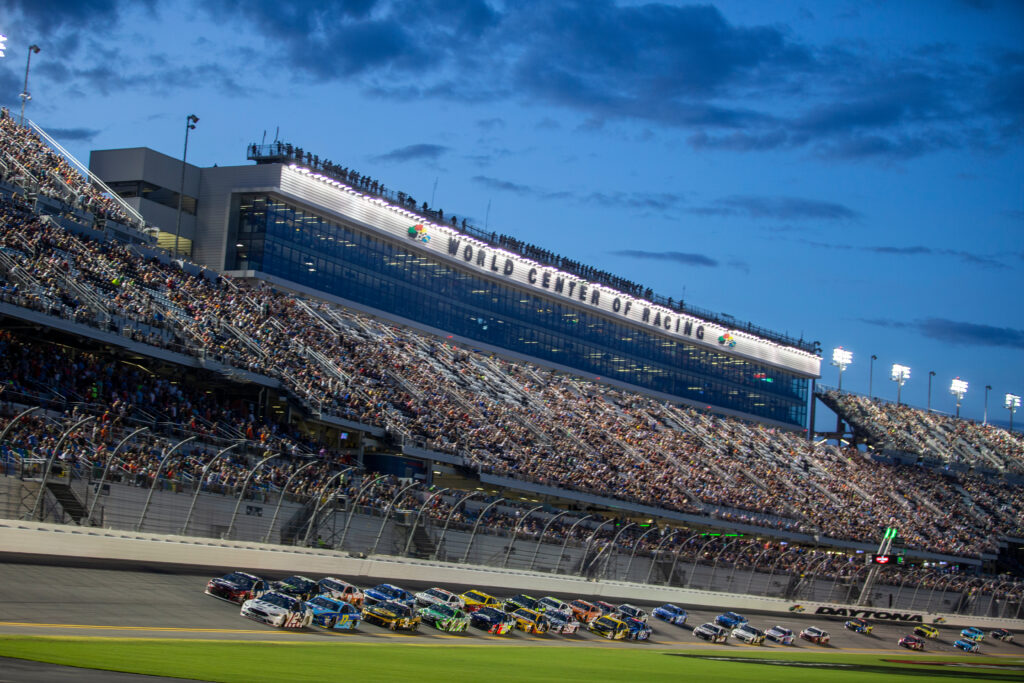
But Daytona is not all speed. Away from the grandstands, the city offers long, walkable beaches, a lively boardwalk, and a coastal calm that reveals itself at sunset. The Ponce de Leon Inlet Lighthouse — Florida’s tallest — stands nearby, a timeless witness to every changing tide and triumph.
Daytona is energy embodied — a place that celebrates motion, not as escape, but as a form of freedom.
Gainesville – The Heart of Knowledge and Nature

Inland and verdant, Gainesville feels worlds away from Florida’s coastal glitter — a leafy, intellectual haven that pulses with youthful energy. Home to the University of Florida, it is as much a city of ideas as of trees.
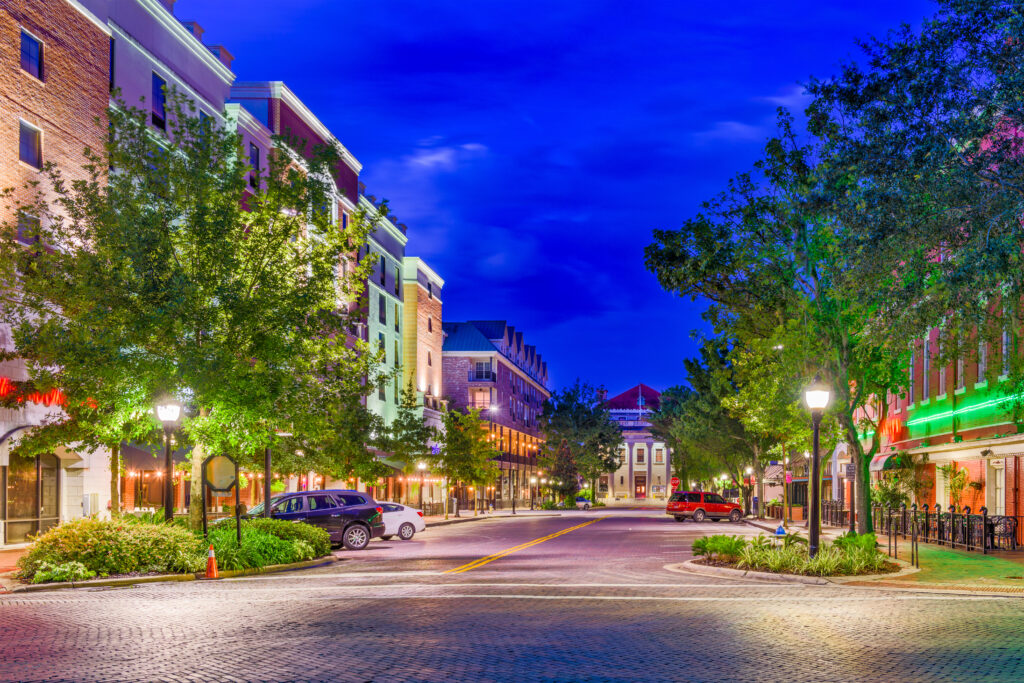
Its shaded avenues and moss-draped oaks give Gainesville an almost Southern Gothic charm, yet beneath that quiet beauty lies constant innovation. The Harn Museum of Art, local music venues, and independent cafés reflect a community both creative and curious.

Nature, too, has a profound voice here. The Paynes Prairie Preserve State Park, a vast expanse of wetlands just south of town, teems with wild horses, bison, and alligators. It is a place of reflection — where you can hear the whisper of old Florida untouched.
Gainesville is intellect with a heartbeat — academic, artistic, and alive.
Tallahassee – The Soul of the Capital
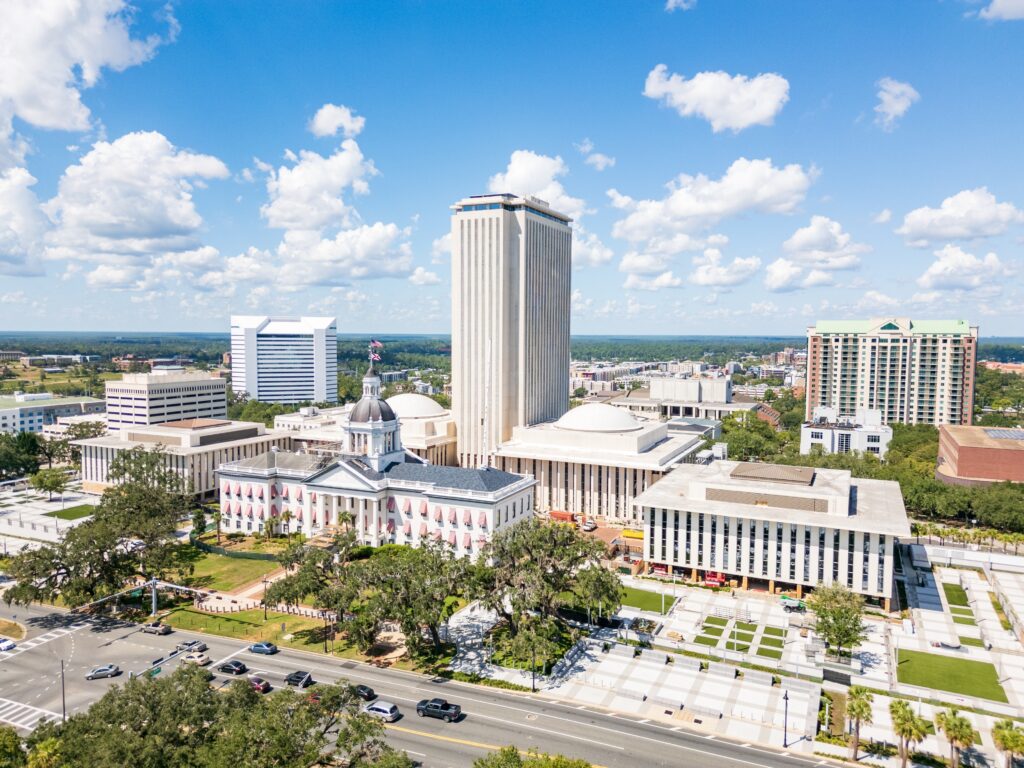
Nestled among rolling hills and towering oaks, Tallahassee feels unlike any other Florida city. As the state capital, it blends the stateliness of government with the ease of the Deep South, all draped in Spanish moss.
The city’s historic district reveals elegant antebellum homes and broad, tree-lined avenues that speak to its storied past. The Florida State Capitol rises at the city’s center, surrounded by the energy of university life from Florida State University and Florida A&M.
Yet Tallahassee is more than politics or academia — it’s a place where art, music, and nature coexist. The Cascades Park and Alfred B. Maclay Gardens State Park show the region’s softer side, with fountains, lakes, and blooms that mirror its thoughtful pace.
Here, Florida’s identity deepens. It is not just the state of beaches and resorts — but one of roots, reflection, and resilience.
Apalachicola & the Forgotten Coast – Florida’s Hidden Soul

Tucked along the Gulf of Mexico, Apalachicola is a whisper of the old South — a fishing town untouched by time, where weathered boats sway in rhythm with the tides and the scent of salt and pine lingers in the air.
This stretch of shoreline, known as the Forgotten Coast, is the antithesis of commercial Florida. There are no high-rises, no sprawling resorts — only marshes, oyster beds, and miles of untouched beach. Apalachicola itself feels preserved in amber: clapboard houses shaded by live oaks, antique shops filled with maritime relics, and the occasional echo of blues guitar drifting from a porch.

The town’s heart beats with its oyster trade, which has shaped the region’s history and cuisine for generations. Local eateries serve oysters so fresh they taste of the tide itself.
To visit Apalachicola is to rediscover Florida’s essence — unhurried, authentic, and rooted in the rhythms of the sea. It’s not forgotten at all; it’s simply remembered by those who listen.
The Emerald Coast – Destin & Fort Walton Beach

Emerald by name and by nature, this coastline of shimmering waters and sugar-white sands is among the most breathtaking in the United States. The Emerald Coast, stretching through Destin and Fort Walton Beach, offers a vision of paradise shaped by light itself.
The sea here is astonishing — crystalline, shifting between turquoise and jade with every breeze. Once a quiet fishing village, Destin is now a blend of luxury resorts, marinas, and vibrant local markets, yet it has retained its easy charm. Charter boats still return each evening with the day’s catch, their silhouettes glowing in the sunset.

Further west, Fort Walton Beach offers family warmth and gentle pace — soft sands, friendly boardwalks, and water that invites you in rather than dazzles from afar. Together, they form a coastline both refined and humble, where nature’s perfection feels effortless.
The Emerald Coast doesn’t shout its beauty. It simply lets you stand still long enough to notice.
Pensacola – The Cradle of Florida’s History
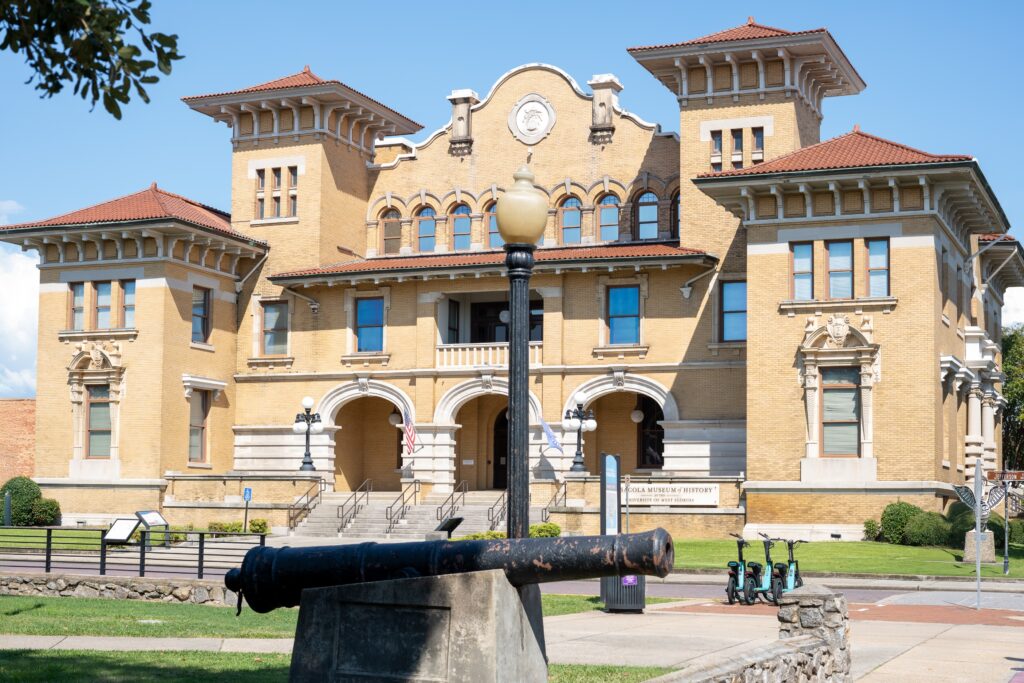
On Florida’s far western edge lies Pensacola, a city older than St. Augustine and shaped by empires. Spanish, British, French, and American flags have all flown here, leaving traces in the architecture, cuisine, and character of this coastal gem.
The Historic Pensacola Village preserves streets of colonial homes, while the National Naval Aviation Museum celebrates the city’s proud military heritage — a soaring tribute to flight, courage, and innovation. Overhead, the Blue Angels practice with thunderous grace, tracing arcs of white smoke across an infinite sky.

Pensacola’s beaches, like those on nearby Santa Rosa Island, stretch endlessly — pale, powdery, and serene. The emerald Gulf laps gently at shores that seem to exist outside of time.
This is Florida’s western soul — old-world and open-hearted, where the past hums quietly beneath the sound of waves. Pensacola may sit at the edge of the map, but it stands at the center of Florida’s story.
Ocala National Forest – The Green Heart of Florida

Deep in the state’s center, the Ocala National Forest spreads like a living tapestry of pine, cypress, and crystalline springs. It is one of the oldest national forests east of the Mississippi, a sanctuary where the air smells of earth and sunlight.
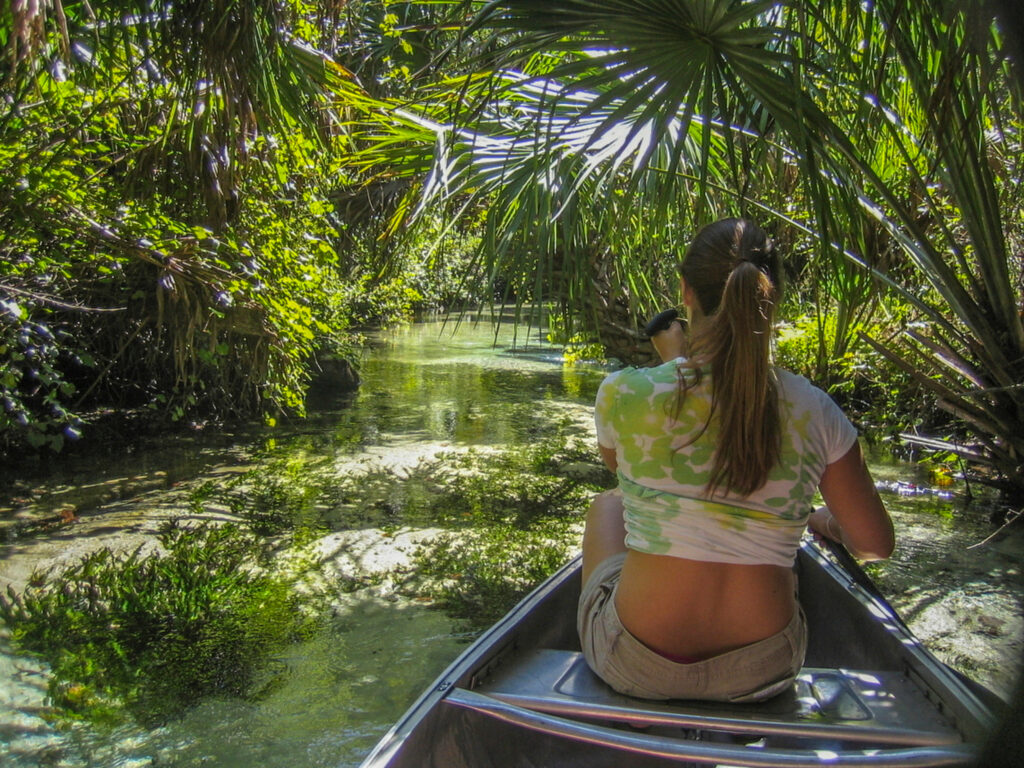
Here, nature feels both intimate and immense. The Juniper Springs shimmer like liquid glass, fed by ancient aquifers; the Silver Glen Springs reflect clouds in perfect stillness. Trails wind through moss-draped hammocks, home to deer, black bears, and countless birds.
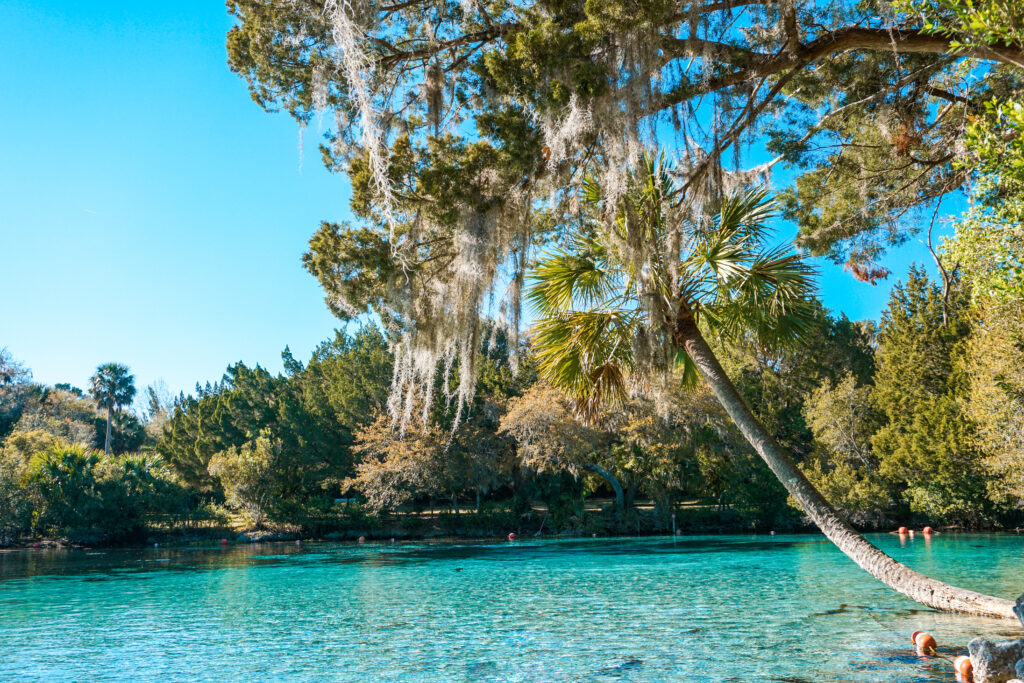
Ocala offers more than escape — it offers recalibration. It reminds you that Florida’s beauty is not only coastal, but also deeply terrestrial, drawn from roots and riverbeds.
Within its quiet expanse, the forest teaches the simplest lesson: to move more slowly, breathe more deeply, and see more clearly.
Mount Dora – The Charm of Old Florida

Set among the rolling hills and sparkling lakes of central Florida, Mount Dora feels like a dream from another century — a town of gingerbread houses, shaded porches, and gentle civility. Its streets slope softly toward Lake Dora, where sailboats drift beneath skies streaked with rose and gold.
Founded in the 1880s, Mount Dora has preserved its Victorian heart with loving care. The historic downtown is filled with antique shops, art galleries, and cozy tea rooms that seem untouched by modern rush. Each year, the Mount Dora Arts Festival transforms the streets into an open-air gallery, reflecting the town’s creative soul.

Nearby, nature quietly encircles the town — from the Palm Island Boardwalk to scenic drives through orange groves and cypress-lined waterways.
Mount Dora is more than a picturesque escape; it is the embodiment of grace — a place that reminds visitors that beauty need not shout to be heard.
Cedar Key – The Island that Time Forgot

Perched on Florida’s Gulf Coast, far from highways and hurry, Cedar Key feels like a secret the modern world never quite found. Once a thriving port in the 19th century, it has become a haven of tranquility and salt-air simplicity.
Wooden docks stretch into still water, pelicans perch on weathered posts, and pastel cottages seem to hum with stories of the sea. The Cedar Key Museum State Park preserves the island’s maritime history, while nearby salt marshes and mangrove channels make it a paradise for kayakers and birdwatchers.

But Cedar Key’s magic lies in its pace — unhurried, timeless, and deeply human. Locals greet visitors as neighbors, seafood is caught hours before it’s served, and sunsets unfold as if choreographed by memory itself.
It’s not forgotten; it’s simply chosen quiet over clamor — and in doing so, has found eternity in simplicity.
Crystal River – The Home of the Manatee

Few experiences in life compare to swimming beside a manatee — those gentle, curious giants who glide through the clear springs of Crystal River. Known as the “Manatee Capital of the World,” this small Gulf Coast town is one of the only places where visitors can meet these creatures in their natural habitat.
The Three Sisters Springs form the heart of this experience — turquoise, pristine, and alive with underwater grace. The water here stays at a steady 72°F year-round, drawing hundreds of manatees during the cooler months.

Beyond its wildlife, Crystal River holds a quiet charm: winding riverside trails, small seafood restaurants, and the serenity of the Crystal River Archaeological State Park, where ancient shell mounds mark the presence of civilizations long past.
Crystal River reminds visitors that Florida’s truest wonders are not built — they are born from water, patience, and care.
Amelia Island – Elegance by the Atlantic
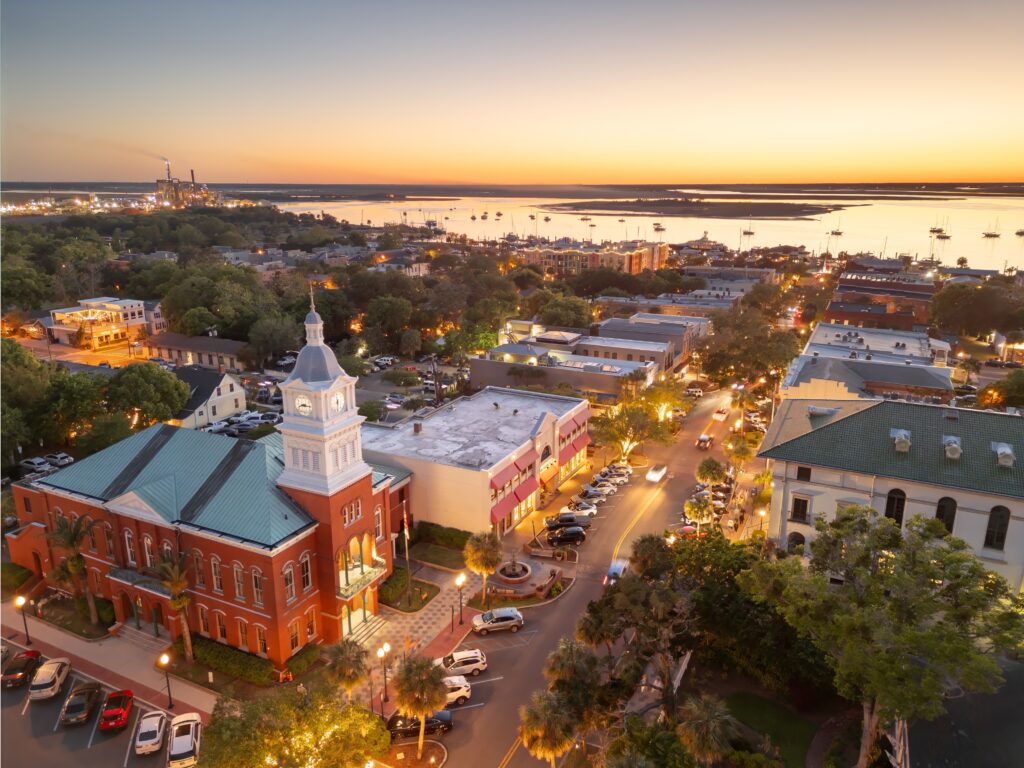
On Florida’s northeastern edge, Amelia Island is a world of maritime grace and historic depth — a place where Spanish moss drapes over cobbled streets, and the Atlantic breeze carries whispers of eight different flags that have flown here over centuries.

The island’s centerpiece, Fernandina Beach, offers a blend of Southern charm and seaside sophistication: Victorian mansions turned into inns, boutique shops housed in old brick buildings, and horse-drawn carriages trotting past art galleries.

Along the shoreline, Amelia Island State Park and Fort Clinch reveal wild dunes and historic forts — where cannons overlook waters now calm and blue. The sea here seems to breathe with memory.
Amelia Island feels like an echo of another time — refined yet relaxed, polished yet profoundly natural. It closes Florida’s story not with spectacle, but with grace.
Fort Lauderdale – Venice of America

Fort Lauderdale is a place where water shapes everything—its rhythm, its identity, even its way of dreaming. Known as the “Venice of America,” the city is a labyrinth of sparkling canals that wind between palms, yachts, and sun-soaked homes, creating a world where the line between land and sea feels purposely blurred. Boats glide as gracefully as cars, slipping past mangroves and marinas, while the scent of salt and sun lotion mingles with flowering hibiscus carried on the breeze.
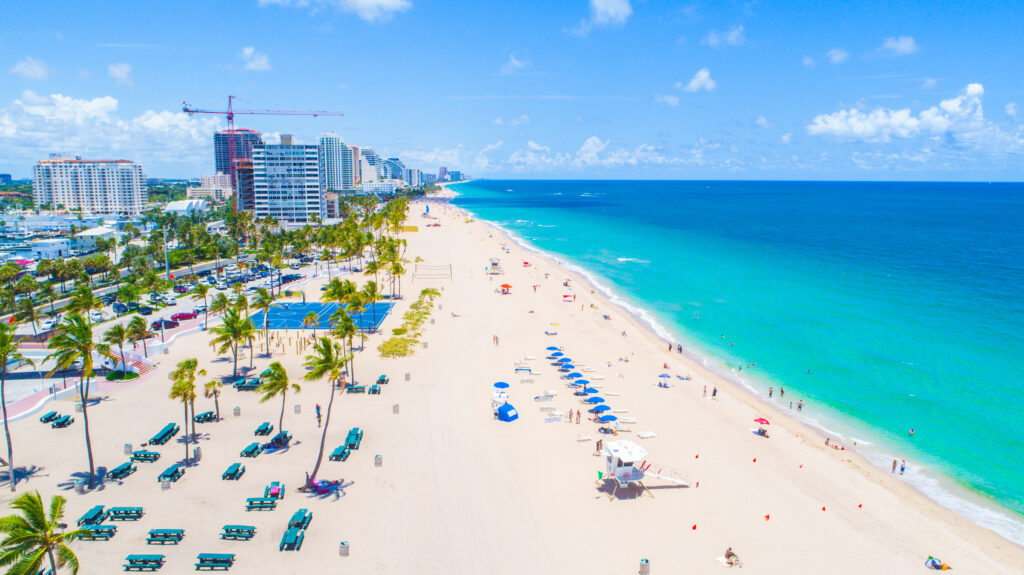
The oceanfront is Fort Lauderdale’s shimmering front porch. Miles of golden sand stretch alongside turquoise water that rolls ashore in gentle, predictable waves. Along the promenade, walkers, cyclists, and morning joggers move beneath swaying palms, and the day feels endlessly wide—slow, warm, and full of possibility. The beaches are lively yet never rushed, offering a coastal calm distinctly different from Miami’s electric pace further south.

Away from the shoreline, the city reveals a softer, quieter soul. The Riverwalk, curving beside the New River, is a serene corridor of shaded pathways, quiet benches, and glimpses of yachts rocking in their berths. Nearby, the Historic Stranahan House offers a window into the city’s pioneer past, reminding visitors that this place once began as a remote river outpost before flourishing into a cosmopolitan coastal center.
The Las Olas Boulevard district weaves together boutiques, galleries, cafés, and garden-lined streets—a blend of urban charm and resort ease. Evenings sparkle with soft lights reflecting on canal waters, and restaurants spill out onto terraces where conversation hums late into the night.
Yet Fort Lauderdale’s true magic lies in the way land and water coexist in harmonious duality. It is a city shaped by tides and breezes, by relaxation and refinement, inviting those who visit to drift, wander, and breathe in the coastal serenity at their own unhurried pace.

